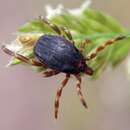en
names in breadcrumbs


Hyalomma ticks are important vectors of the virus causing Crimean-Congo Hemorrhagic Fever. Ticks in this genus parasitize domestic and wild mammals and birds and are abundant in semi-arid zones. Most Hyalomma species have 3-host life cycles, but some species undergo either a 2-host or 3-host cycle depending on the host; ticks of at least one species (H. scupense) have a 1-host life cycle. Unlike most other ixodid ticks, which wait on vegetation for a host to pass, adult Hyalomma actively run out from their resting sites when a host approaches. (Jongejan and Uilenberg 2004)
Hyalomma is a genus of hard-bodied ticks common in Asia, Europe, and North Africa. They are also found in Southern Africa. The name is derived from Greek: hyalos (ὕαλος) crystal, glass; and omma (oμμα) eye.
The genus is believed to originate from the area of the present-day Iran or the southern part of the former Soviet Union, having then had spread further into Asia, including the Middle East, and to southern Europe and Africa.[1]
Hyalomma are larger in size and do not have protective shields (indistinct festoons), but have eyes and banded legs. Hyalomma species are difficult to identify due to their hybridization and genetic and morphological variations, caused by harsh environmental conditions and lack of food sources. Hyalomma species are the only ticks to live in such harsh desert conditions. With few hosts available, they are required to be active as soon as a potential host is sensed.
Adult Hyalomma can bite humans and transmit serious pathogens. Immature (nymph) Hyalomma usually feed on birds, rodents, and hares and can be the cause of viral disease and rickettsias. Nymphs are often transmitted from one place to another by migrating birds. For example, a migrating bird carrying a Hyalomma marginatum nymph can cause Crimean-Congo hemorrhagic fever.[1] Hyalomma species can also transmit rickettsias like Siberian tick typhus, Boutonneuse fever, and Q fever.[1]
Hyalomma is a genus of hard-bodied ticks common in Asia, Europe, and North Africa. They are also found in Southern Africa. The name is derived from Greek: hyalos (ὕαλος) crystal, glass; and omma (oμμα) eye.
The genus is believed to originate from the area of the present-day Iran or the southern part of the former Soviet Union, having then had spread further into Asia, including the Middle East, and to southern Europe and Africa.
Hyalomma are larger in size and do not have protective shields (indistinct festoons), but have eyes and banded legs. Hyalomma species are difficult to identify due to their hybridization and genetic and morphological variations, caused by harsh environmental conditions and lack of food sources. Hyalomma species are the only ticks to live in such harsh desert conditions. With few hosts available, they are required to be active as soon as a potential host is sensed.
Adult Hyalomma can bite humans and transmit serious pathogens. Immature (nymph) Hyalomma usually feed on birds, rodents, and hares and can be the cause of viral disease and rickettsias. Nymphs are often transmitted from one place to another by migrating birds. For example, a migrating bird carrying a Hyalomma marginatum nymph can cause Crimean-Congo hemorrhagic fever. Hyalomma species can also transmit rickettsias like Siberian tick typhus, Boutonneuse fever, and Q fever.